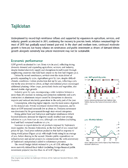ADB: Tajikistan Outlook for 2012
Underpinned by record-high remittance inflows and supported by expansion in agriculture, services, and industry, growth accelerated in 2011, continuing the recovery to pre-crisis levels. Inflation remained high for most of 2011 but gradually eased toward year-end. In the short and medium term, continued moderate growth is forecast, but heavy reliance on remittances and public investment as drivers of demand-driven growth alongside extremely low private investment may not be sustainable.
GDP growth accelerated to 7.4% (from 6.5% in 2010), reflecting strong domestic demand and expanding agriculture, services, and industry, despite limited electricity supply and disruptions to rail transit. Driven by record remittances, services were the main driver of growth, expanding by 13.5%. Agriculture grew by 7.9%, despite difficult climatic conditions. Cotton production shot up by 34%, reflecting a 30% rise in the area devoted to cotton. Industry grew by 5.9%, encompassing a wide variation between a more than 38% increase in mining and extraction industries and a 16% contraction in aluminium output.
Increases in export duties for oil products imposed by Tajikistan’s main supplier, the Russian Federation, in the first half of 2011 raised fuel prices by 59%. Food price inflation peaked in that half in response to rising world prices.
Remittances will continue supporting aggregate demand, but GDP growth is forecast to decline to 5.5% in 2012, reflecting slower growth in the Russian Federation and other key trading partners, before recovering to 6.0% in 2013 as the world economy improves. Although the overall outlook for exports is uncertain, construction of an international power line and the signing of an export agreement in 2011 should boost summer exports of electricity to Afghanistan in 2012 and 2013.
Agriculture’s performance will depend heavily on cotton output, which could expand further if global cotton prices stay high. Industry (including construction) and services will continue to fuel growth but at slower rates than in 2011 because of continued problems in the power sector, limited supplies of inputs, and aging production facilities, particularly in aluminium.
Inflation is forecast to stay around 8.5–9.0% in the next 2 years.

